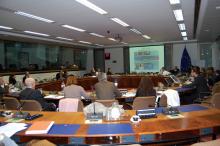
On 16 June 2016, a conference gathering of more than 90 participants in Brussels, Belgium, took stock of the achievements of the Social Dialogue Agreement on Workers’ Health Protection through the Good Handling and Use of Crystalline Silica and products containing it, ten years after its signature.
In a video message, Commissioner Marianne Thyssen reiterated the European Commission’s support to the
Mrs Thyssen also referred to the European Construction Industry, where she underlined that ‘exposure risks are highest’, and that the sector is not currently part of the NEPSI Agreement. She said that it would ‘be great if this were to change’.
What is NEPSI?
NEPSI is the acronym for the European Network for Silica formed by the employee and employer European sectoral associations, having signed the Social Dialogue Agreement on 25 April, 2006, to which
All information (from signatories to guidance documents) are available on NEPSI’s brand new website at www.nepsi.eu.
NEPSI success story
Among NEPSI’s achievements, it has been demonstrated over the last ten years that the NEPSI Agreement is a unique tool to improve workers’ protection on the work floor thanks to the respirable crystalline silica dust reduction measures described in the evolving Good Practice Guide, translated in 24 languages.
Together, the NEPSI 15 signatory industry sectors and IndustriAll, the European Trade Union Federations, have facilitated the implementation of good practices in dust reduction measures and also monitored the application of the Agreement through five biennial reports of key performance indicators.
In 2015-2016, the EU co-financed a NEPSI communications campaign that includes setting up explanatory videos on NEPSI added-value and activities as well as a series of webinars in eight languages targeting new sectors and NEPSI OSH (occupational safety and health) managers. In addition, the NEPSI website was renewed.
UEPG believes that prevention is crucial. This is the focus of the NEPSI EU Social Dialogue Agreement on Crystalline Silica Good Handling and Use which, it is widely agreed, provides adequate control measures and workers protection.
In reality, the biennial NEPSI Reporting provides incentives to companies to improve continuously the protection of workers as shown in NEPSI Reporting 2016.
Ten years on, at the end of the conference on 16 June, 2016, the NEPSI signatories signed a Joint Declaration confirming their desire to continue working together for enhanced workers’ health protection and to make sure that the NEPSI Agreement has a central role in facilitating compliance with the recently proposed European regulatory measures.
The status of respirable crystalline silica regarding EU occupational safety and health legislation , currently there is no pan-European Limit value addressing respirable crystalline silica exposure.
On 13 May, 2016, EU Commissioner Thyssen presented a proposal to revise the Carcinogens and Mutagens Directive at work (CMD). On this occasion, the Commission proposed to include in Annex I “work involving exposure to respirable crystalline silica dust generated by a work process” and to establish in Annex III a Binding Limit Value for respirable crystalline silica dust (‘respirable fraction’) at 0.1mg/m³.
The NEPSI Signatories acknowledge the Commission’s proposal for this Binding Limit Value which aims to protect workers while defining a clear “level playing field” across the EU.
The Recital 6 of the proposed amendment of the Carcinogens and Mutagens Directive acknowledges NEPSI Good Practices’ role as a valuable instrument to complement regulatory requirements and to support their effective implementation.
The EU Directive proposal will first need to be adopted by the EU Council and the European Parliament under the ordinary legislative procedure (COD). Then it needs to be transposed into national legislation by each of the Member States, and only after that the competent local authorities and inspectors will start using the new regulations.
The work of the EU Council has already started over its Working Party on Social Questions.
The European Parliament has by this time nominated a Rapporteur under the Employment and Social Affairs Committee, MEP Marita Ulvskog (S&D, Sweden), and Shadow Rapporteurs, MEP Rolin Claude (EPP, Belgium), and Patrick Le Hyaric (GUE/NGL, France).
UEPG in line with other NEPSI Signatories is closely monitoring the development of the proposal now at the EU Council and European Parliament level, communicating to its members’ the latest information and guidance documents to best represent UEPG Members’ interest in a common NEPSI advocacy campaign.







